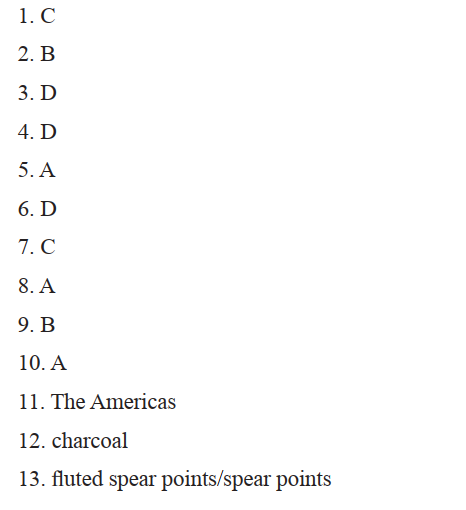Table of Contents
Passage
A Before humans arrived, The Americas were home to woolly mammoths, sabertoothed cats, giant ground sloths and other behemoths, an array of megafauna more impressive than even Africa boasts today. Researchers have advanced several theories to explain what did them in and when the event occurred.
B One prominent theory pegs humans as the cause of the demise, often pointing to the Clovis people, who left the earliest clear signs of humans entering the New World roughly 13,500 years ago. The timing coincides with the disappearance of megafauna, suggesting the Clovis hunted the animals to extinction or infected them with deadly disease. Another hypothesis supposes that climate was the culprit: it had swung from cold to warm twice, including a 1,300-year-long chill known as the Younger Dryas; such abrupt shifts might have overwhelmed the creatures, abilities to adapt.
C To pin down when the megafauna vanished, paleoecologist Jacquelyn Gill of the University of Wisconsin-Madison and her colleagues analyzed fossil dung, pollen and charcoal from ancient lake sediments in Indiana. The dung of large herbivores harbors a fungus known as Sporomiella, and its amounts in the dung gives an estimate of how many mammoths and other megafauna were alive at different points in history. Pollen indicates vegetation levels, and charcoal signals how many fires burned; the extent of flora and wildfires is related to the presence of herbivores. Without mega herbivores to keep them in check, broad-leaved tree species such as black ash, elm and ironwood claimed the landscape; soon after, buildups of woody debris sparked a dramatic increase in wildfires. Putting these data together, Gill and her team conclude that the giant animals disappeared 14,800 to 13,700 years ago-up to 1,300 years before Clovis.
D A different study, however, suggests that this mass extinction happened during Clovis. Zooarchaeologist J. Tyler Faith of George Washington University and archaeologist Todd Surovell of the University of Wyoming carbon-dated prehistoric North American mammal bones from 31 different genera (groups of species). They found that all of them seemed to meet their end simultaneously between 13,800 t0 11,400 years ago.

E But if ancient DNA recovered from permafrost is any sign, megafauna survived in the New World millennia after humanity arrived. As the permafrost in central Alaska cracked during springtime thaws, water that held DNA from life in the region leaked in, only to freeze again during the winter. As such, these genes can serve as markers of “ghost ranges”-remnant populations not preserved as fossil bones. Looking a t mitochondri a l DNA, evolutionary biologist Eske Willerslev of the University of Copenhagen and his colleague suggest mammoths lasted until at least 10,500 years ago (as did horses, which actually originated in the Americas only to vanish there until the Europeans reintroduced them).
F Although the three papers appear to conflict with one another, they could be snapshots from the beginning, middle and end of a mass extinction. “If they seem to disagree, it is for the same reason as in chat fable about the three blind men trying to describe an elephant-or mammoth?-by touching different parts of it, “ says ecologist Christopher Johnson of James Cook University in Australia, who did not take part in any of the studies.
G Johnson suggests the fungus research is superb evidence for when the decline began, but it is not as good at confirming exactly when the extinction was completed, especially over larger areas, populations might have persisted. The DNA finds, on the other hand, can detect late survivors, he says, “maybe very close to the actual time that the last individuals were alive, at least in Alaska.” The bones analyzed from the period roughly in between show that the extinction process afflicted many species simultaneously. Those fossils came from the contiguous US, which back then was separated from Alaska by the massive Laurentide and Cordilleran ice sheets and so, Faith notes, could explain why the pattern of extinction differed up there.
H So what caused the decline? The jury’s still out, says Willerslev’s collaborator Ross MacPhee of the American Museum of Natural History in New York City. Johnson notes that archaeologists are turning up evidence of humans in the New World before Clovis, and he suggests they overhunted the megafauna. The beautifully crafted fluted spear points linked with the Clovis might reflect strategies chat developed once the giants became rare and harder to hunt, Johnson adds.
I Even if scientists cannot definitively finger the killer, research into the megafauna disappearance “is directly relevant today because we are in the middle of a mass extinction and one for which we know the cause”, Gill says. “Large animals are among the most threatened today,” she points out, and no one wants Africa to follow the ancient experience of the Americas.
Questions
Questions 1-3 Choose the correct letter, A, B, C or D. Write your answers in boxes 1-3 on your answer sheet.
1 Mammoths are animals that
A still exist recently in the Americas
B sometimes consumed fleshes, for example horses
C faced extinction at least 10,000 years ago.
D nobody has found their DNAs yet
2 Clovis people is a group of people who
A are regarded as the earliest existence of humans.
B may be the main cause of extinction of mammoths.
C lived in somewhere in Africa.
D appeared before the human of the New World.
3 Christopher Johnson suggested that
A Clovis people overhunted mammoths in his study.
B mammoths lived in the Americas.
C megafauna faced extinction before the New World by DNA testing.
D researchers in the passage may not be contradictory to each other.
Questions 4-10 Use the information in the passage to match the people (listed A-D) with opinions or deeds below. Write the appropriate letters A-D in boxes 4-10 on your answer sheet.
NB you may use any letter more than once.
A Jacquelyn Gill
B J. Tyler Faith
C Eske Willerslev
D Christopher Johnson
E Ross MacPhee
4 Human came before Clovis might overhunted mammoths already.
5 Clovis was excluded from the cause of mammoths’ extinction.
6 Fossils of fungi could not prove when exactly the extinction was finished.
7 Genes could be used to show when the extinction happened.
8 Big animal eating plants in the area pose a competition to large pieces of forest, with big leaves trees.
9 Extinction estimation could be done by tracking the carbon particles inside the dead bodies of mammoths.
10 Humans are playing a role of major culprit of giant loss globally
Questions 11-13 Answer the questions below. Choose NO MORE THAN THREE WORDS AND/OR A NUMBER from the passage for each answer.
11 Where did giant ground sloth once live?
12 Which fossils could be regarded as evidence of vegetable consumed in a fire?
13 What kind of tools did the Clovis develop to hunt vanishing mammoths?
Answers




Answers with explanation